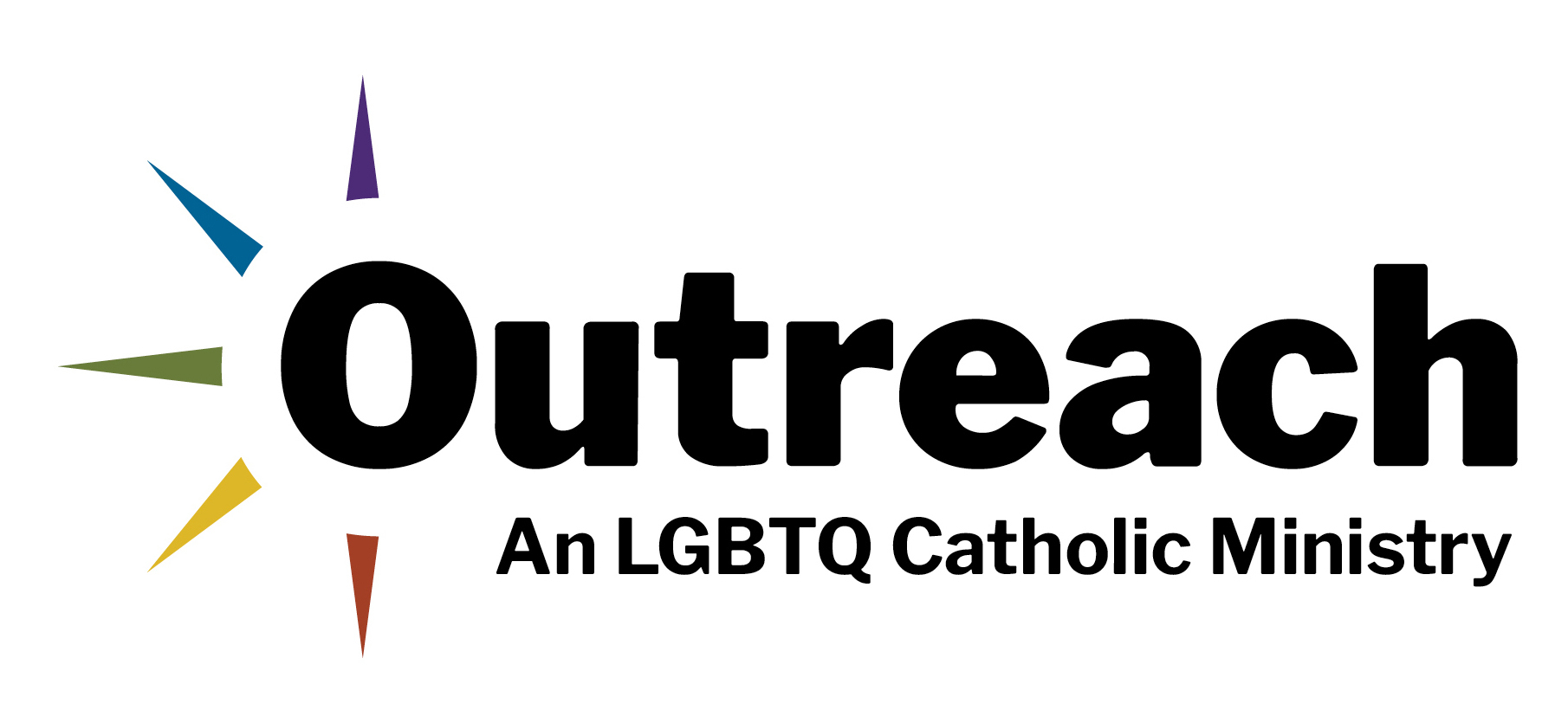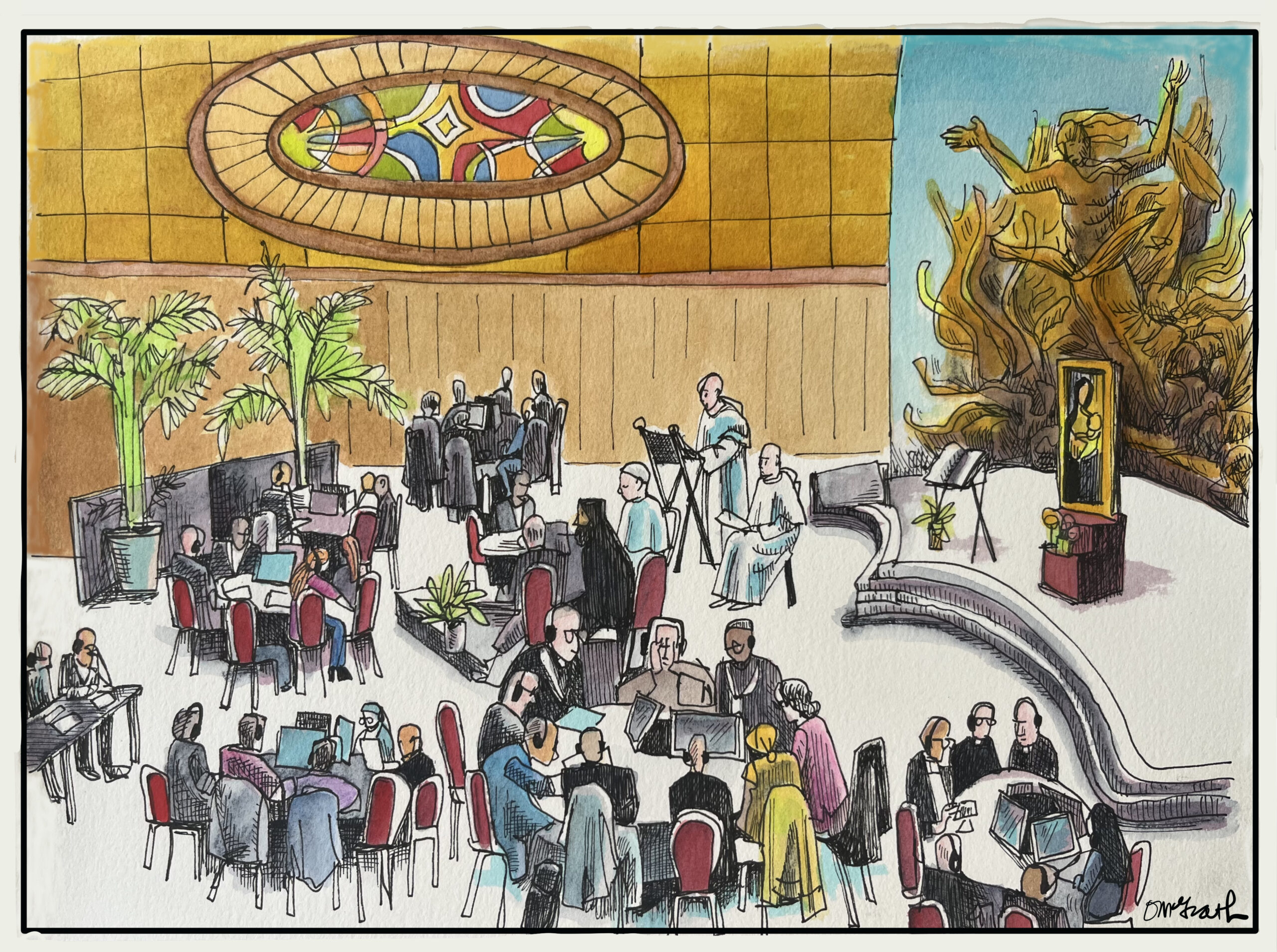Drawing is my favorite way to be contemplatively present to the present moment.
In the early days of the AIDS pandemic, for example, I lost a dear friend—who was also a wonderful priest—to the disease. While my community handled it very sensitively and non-judgmentally, as did other church communities and ministries, much of the Christian world at large was filled with fear and angry judgment leveled at the gay community. As an artist, my response in that challenging time was to paint an image of Christ holding a young man in his arms with the words from Night Prayer: “Night holds no terror for me sleeping under God’s wings.” It was not only a consolation for me, but a gentle reminder that nothing should be more important to a Catholic Christian than the basic law and rule of the Sacred Heart of Christ: to love, to seek love, to share love, and to be love.
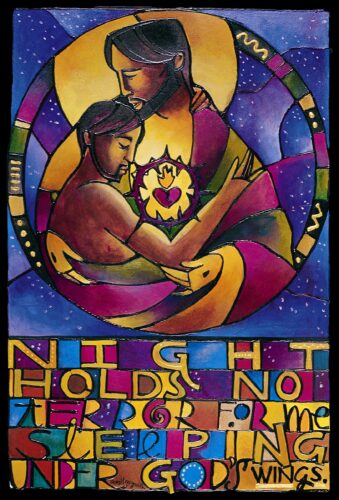
Part of my inspiration to sketch at the Synod on Synodality in Rome came from Frederick Franck, one of my favorite modern artists. Out of his great love and admiration for Pope John XXIII, he flew to Rome without a single connection or reference, and yet became an official artist of the Second Vatican Council. With his magical pens and watercolors he recorded everything from the pageantry of Cardinals and bishops processing into St. Peter’s Basilica to their mid-day coffee breaks. In the evenings, he would sketch portraits of bishops and theologians while engaging them in conversation. As a Buddhist artist from a Protestant background with deep respect for Catholicism, Franck longed for ecumenical reform in the modern church. He was the ultimate creative outsider whose drawings, reflections and observations are as relevant to me today as they ever were.
So, last year, I began to think that maybe I could do at the Synod what Franck did at Vatican II, and bear witness to this historic continuation of the reforms of Vatican II with my own eyes and hands. In the early 1960s, Franck’s hopes and dreams centered on the idea of the Roman church opening wide its doors to the challenges facing the modern world, and acknowledging the voices and presence of church leaders worldwide—including theologians who had been silenced under the previous leadership. He hoped that issues of social justice and works of mercy would take precedence over pious traditions and legalism rooted in a past no longer relevant in the post-WWII world. As a visionary artist, Franck chose time and time again to follow the Holy Spirit, who does not fly backwards.
Sixty years later, the ecumenical spirit Franck dreamed of is a reality, the Mass is celebrated in native tongues, and concerns for social justice have made a home in most Catholic hearts and imaginations. But in many parts of the world, the number of “practicing Catholics” has dropped drastically while the number of “non-practicing” Catholics has risen sharply. Many of those who still identify as Catholic, this artist included, long to hear the voices and glean the spiritual insights of women, LGBTQ people, and folks from a wider array of cultural backgrounds than straight, white, Western clerics. As St. Francis de Sales used to say: “The Church is a multi-colored garden.”
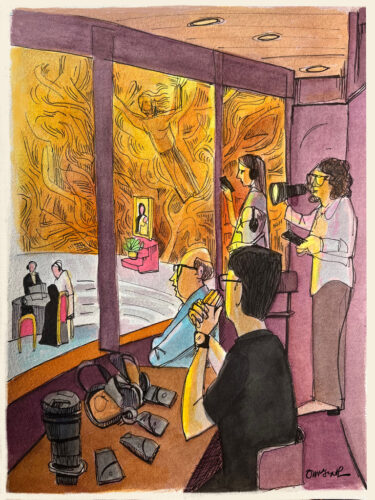
After months of anticipating it with great excitement—and with the help of well-connected friends—I was granted access to the Vatican’s Paul VI Aula to artistically render the goings-on at the synod this past October. I sat with a small group of journalists in the press booth, a narrow passageway behind a long glass wall looking down into the assembly of synod delegates seated at round tables far below. Because I was given permission to sketch for only 45 minutes, I had to ignore my initial moments of panic at not knowing where or how to begin. How would I ever fit this huge gathering of delegates on a nine-by-twelve inch pad of watercolor paper? But then I remembered that I had once sketched while riding on the back of a motorcycle, my sketch pad propped on the driver’s back of my easel. Surely I could pull this off.
I saw lots of men dressed in clerical attire sitting alongside other men in suits and ties. But I was most pleased to note the presence of many women, some in veiled religious habits, all of them seated at the same round tables as the men. From my vantage point, Pope Francis in his white cassock was obstructed by an Orthodox patriarch big as a bear and dressed in black from head to toe. I felt like throwing a note down asking him to remove the headgear and move just a little to the left so I could see Il Papa more clearly. Taking some artistic license, behind them I sketched now-Cardinal Timothy Radcliffe, O.P., the renowned Dominican theologian who was delivering what I am sure was a terrific sermon—only I was concentrating too heavily on my sketch to pay close attention to his words, which somehow involved Canaanite dogs. I finished my first drawing in 30 minutes, and with the clock still ticking, I turned and sketched the other journalists and officials in the press booth for the remaining fifteen minutes of the allotted time. I added the watercolors in the following days.
Both before and after my brief time there, I had to remind myself that the synod was about focused listening, not policy-making; that the possibility of diaconate ordination for women and priesthood for married men, as well as official recognition that LGBTQ folks are not seriously disordered would have to come at a much later time. After all, 60 years after the Second Vatican Council, we continue to see its vision take flesh—in part through the Synod on Synodality itself. This was simply a time to listen to the voice of the Spirit, a time to put judgments aside. The fact that the synod was happening at all in this very slow moving ship of a church was of historic significance, a small step and a giant leap at the very same time. A promising outcome is that the synodal process is now meant to be a mandatory process throughout the church.
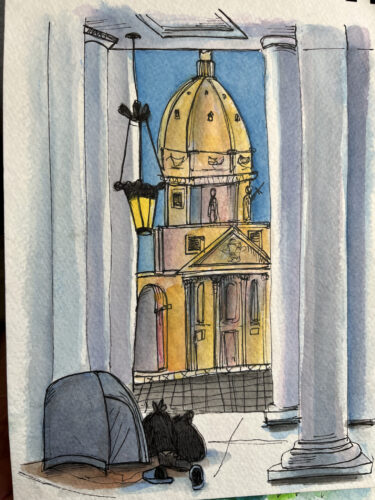
As I made my way around St. Peter’s Square after leaving the Paul VI Aula, I stopped to sketch the pup tent of a homeless person amidst the columns in the colonnade designed by Gian Lorenzo Bernini way back in the 17th century. Bernini sought to represent the arms of Mother Church reaching out to the world and gathering people in with his colonnade. Seeing this man, I immediately felt at home—desperate people without homes, jobs or mental or emotional healthcare continually roam the streets of Camden, N.J., where I have lived for sixteen years. From Camden to Rome, it is the work of the church to embrace these people, and I join many Catholics in praying that the synod can help us listen to our poor brothers and sisters and serve them more effectively.
Over the next few days I returned to that holy spot to do some more sketching in a spirit of familiarity, solidarity and hope. The same Pope Francis who made the synod finally happen is the same man who cares deeply for the homeless folks around St. Peter’s Square and does his best to provide for their needs. Sketchbook in hand, I witnessed two radically different yet integrally connected instances of Mother Church opening wide her arms: Inside Paul VI Hall, where a host of history-making synod delegates gathered from around the world to breathe new life into the church; and outside, where our homeless brothers and sisters find some relief from their terrors sleeping under the eternal warmth of God’s Sacred Heart.
